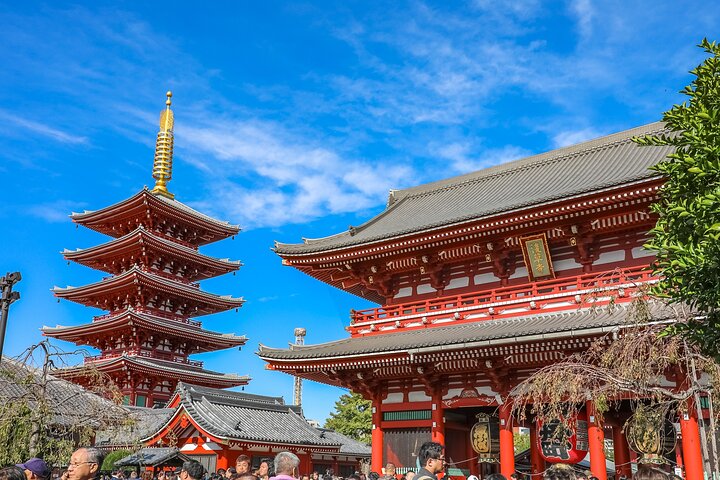Get to know the secret of Asakusa! Shrine and Temple Tour
Share this tour

Offered languages
- English
There are many temples and shrines with a long history and interesting characteristics in Asakusa where the common culture of Edo flourished. It was believed that since the seven disasters would be eliminated by visiting shrines where the seven gods enshrined, and visitors would receive seven happiness.
Even in Japan today, visiting temples and shrines is a secret boom. At each shrine, you can get a red stamp as a sign of worship, so you can enjoy collecting red stamps. This attractiveness has become popular and is attracting the attention of young people.
In this tour, you will go around Asakusa and visit seven shrines. You can see not only the Sensoji but also the quiet and calm city!
What's Included
Meeting and pickup
Tokyo Metro Ginza Line Asakusa Station (G19) Exit 1
Itinerary
-
1Honryuin Matsuchiyama Shoden
Matsuchiyama Shoden: This is a temple famous for health, good relations, and marital relations, and represents the prosperous business. Of the seven deities of good fortune, "Bishamonten", the god that gives good fortune and courage, is enshrined.
25 minutes • Admission ticket free -
2Imado Shrine
Imado Shrine: This shrine is famous as the birthplace of Maneki Neko, and there are Maneki Neko everywhere! It is a shrine where many female worshipers have the luck of marriage. Among the seven deities of good fortune, the deity of good luck, property and health, "Fukurokuju" is enshrined.
20 minutes • Admission ticket free -
3
Hashibafudo-son: A small, simple temple where you can feel the beauty of the architectural style of the Edo period. Among the seven deities of good fortune, "Hotei-son", the deity of good fortune and good luck, is enshrined.
15 minutes • Admission ticket free -
4
Ishihama Saryo Raku: This is a restaurant located within the grounds of Ishihama Shrine. The restaurant has an open space with a wide variety of menu items, including sweets such as tempura bowl, soba, and dango. You can also enjoy tofu dengaku, which was a specialty of the precinct teahouse that was depicted in ukiyo-e prints during the Edo period.
40 minutes • Admission ticket not included -
5Yoshiwara Shrine
Yoshiwara Shrine: This is the only female god of the seven deities, that enshrines "Benzaiten". It is said to fulfill various wishes of women and is said to have particularly the luck for art and marriage.
20 minutes • Admission ticket free -
6
Otori Shrine: This is a shrine with a gorgeous and large rake, which is famous for holding the "Rooster Market" where the lucky rakes are sold. The symbol is the mask used in Japanese Noh, "Okame-san". Let's stroke the giant turtle! Among the seven deities of good fortune, the God of good health and longevity, the "Jurojin," is enshrined.
20 minutes • Admission ticket free -
7Asakusa Shrine
Asakusa Shrine: Asakusa Shrine, which has a deep relationship with the famous sightseeing spot "Sensoji Temple", is dedicated to "Ebisu," which is one of the seven lucky deities of good fortune and good luck. This is the shrine that holds the three major festivals in Tokyo.
15 minutes • Admission ticket free -
8Senso-ji Temple
Sensoji Temple: It is the oldest temple in Tokyo with a large red lantern that is a symbol of Asakusa. The beautiful vermillion landscape is spectacular and has become a famous tourist spot that most tourists visit here. On Nakamise-Dori, which leads to the main shrine, many souvenirs unique to Japan are on sale! Among the seven deities of good fortune, Daikokuten is enshrined at Sensoji Temple.
30 minutes • Admission ticket free -
9Nakamise Shopping Street (Kaminarimon)
Asakusa Nakamise Shopping Street: Let's walk the Nakamise Shopping Street, which is the busiest area in Asakusa. We will guide you through the recommended shops where you can buy souvenirs and eat famous local foods. Don't forget to take a photo near the Kaminarimon gate as well!
20 minutes • Admission ticket free
Additional info
- Infants and small children can ride in a pram or stroller
- Public transportation options are available nearby
- Suitable for all physical fitness levels
- All transportation costs, entrance fees, food and drink costs, etc. incurred at the visited spots, will be borne by the customer.
- Tour finishing spot is different from starting spot. Please let your tour guide know if you would like to change the finishing spot.
- On Wednesday, "Ishihama Saryo Raku" is closed, so we will show you an alternative spot.
Tags
Cancellation Policy
For a full refund, cancel at least 24 hours before the scheduled departure time.
Show more
Cancellation Policy
- For a full refund, you must cancel at least 24 hours before the experience’s start time.
- If you cancel less than 24 hours before the experience’s start time, the amount you paid will not be refunded.
- Any changes made less than 24 hours before the experience’s start time will not be accepted.
Rating
You can cancel up to 24 hours in advance of the experience for a full refund.
Your guide to the flawless travel experience











